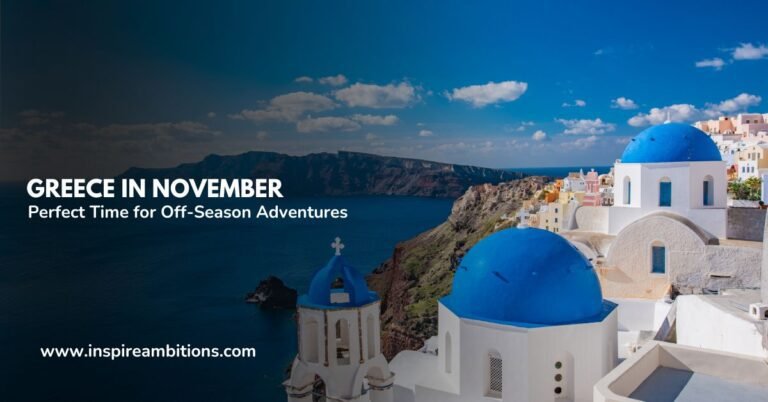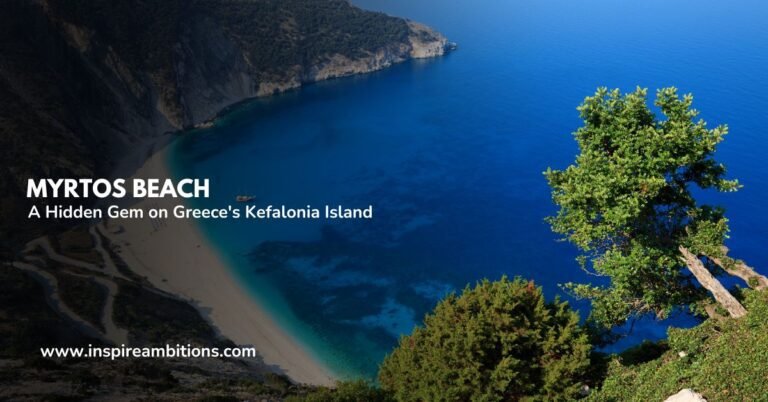Corinth – Greece – Ancient City with Modern Charm
Corinth, Greece – a name that conjures images of ancient glory and modern charm.This fascinating city offers a unique blend of history and contemporary life. Straddling the narrow isthmus connecting the Peloponnese peninsula to mainland Greece, Corinth boasts a strategic location that has shaped its destiny for millennia.

You’ll find the ancient ruins of Corinth about 50 miles west of Athens, perched on a terrace overlooking the Gulf of Corinth. As you explore, you’ll walk in the footsteps of legendary figures like St. Paul and Julius Caesar. The Temple of Apollo stands as a testament to the city’s former grandeur, inviting you to imagine its past splendour.
Modern Corinth, rebuilt after an earthquake in 1858, offers its attractions. You’ll marvel at the Corinth Canal, a feat of engineering that cuts through the isthmus. This narrow waterway, connecting the Gulf of Corinth to the Saronic Gulf, provides a stunning photo opportunity and a glimpse into Greece’s maritime importance.
Corinth, Greece – Ancient City
lets explore
历史文化
Corinth’s rich tapestry of history and culture spans millennia, weaving together ancient myths, powerful rulers, and pivotal moments that shaped Western civilization. From its humble Neolithic beginnings to its role in early Christianity, this Greek city-state has left an indelible mark on the world.
Ancient Beginnings and City-State Emergence
You might be surprised to learn that Corinth’s roots stretch back to the Neolithic period. By the 8th century BC, the city had blossomed into a thriving metropolis. Its strategic location on the isthmus connecting mainland Greece to the Peloponnese made it a hub of trade and naval power.
The Cypselid dynasty, led by Cypselus and his son Periander, ushered in an era of prosperity. Under their rule, Corinth became renowned for its wealth, art, and architecture. The city’s famous Corinthian column style emerged during this period, leaving a lasting impact on classical architecture.
Corinth’s rivalry with Athens and alliance with Sparta during the Peloponnesian War showcased its political clout in the ancient Greek world.
Roman Rule and the New Testament Connection
Julius Caesar’s rebuilding of Corinth in 44 BC marked the beginning of Roman influence. The city flourished as a Roman colony, becoming the capital of the province of Achaea.
You’ll find Corinth prominently featured in the New Testament. Saint Paul’s visits to the city and his letters to the Corinthians played a crucial role in the spread of early Christianity. His teachings addressed the unique challenges faced by the diverse and cosmopolitan Corinthian community.
The city’s strategic importance and cultural blend made it a melting pot of ideas, religions, and philosophies during this period.
Medieval Period and Modern Developments
After the fall of the Roman Empire, Corinth faced numerous challenges. The city changed hands multiple times between Byzantine rulers, Crusaders, and Ottoman Turks.
You might be interested to know that the Venetians briefly controlled Corinth in the late 17th century. Their rule left architectural and cultural imprints still visible today.
During the Greek War of Independence in the 1820s, Corinth played a significant role in the struggle for freedom. The modern city, rebuilt after a devastating earthquake in 1858, continues to thrive alongside its ancient ruins.
Today, you can explore Corinth’s archaeological sites, which offer a fascinating glimpse into its layered history and enduring cultural legacy.
Geography and Strategic Importance
Corinth’s unique location on the Isthmus of Corinth has shaped its history and importance for millennia. This narrow strip of land connects mainland Greece to the Peloponnese, giving Corinth control over vital trade routes and military passages.
The Isthmus and Connecting Seas
The Isthmus of Corinth is a narrow land bridge about 4 miles wide. It links the Peloponnese peninsula to mainland Greece, separating the Gulf of Corinth from the Saronic Gulf. This strategic position allowed Corinth to control trade between these two bodies of water.
You could imagine ancient merchants eagerly awaiting their turn to transport goods across the isthmus. Ships would dock on one side, unload their cargo, and move it overland to waiting vessels on the other side. This method called the diolkos, saved time and avoided dangerous sea routes.
The city’s location also gave it access to two significant seas:
- Ionian Sea to the west
- The Aegean Sea to the east
This dual access made Corinth a bustling hub of maritime commerce in the ancient world.
Earthquakes and Reconstruction
Living in Corinth, you’d need to be prepared for the ground to shake beneath your feet. The city sits in a seismically active zone, making it prone to earthquakes throughout its history.
Major quakes have repeatedly devastated Corinth:
- 365 AD: A massive earthquake destroyed much of the Roman city
- 1858: Villages of Ancient Corinth and Hexamilia were damaged
- 1928 and 1930: Old and New Corinth suffered significant damage
After each disaster, Corinthians have shown remarkable resilience. They’ve rebuilt their city time and time again, often improving its defences and infrastructure in the process.
The modern Corinth Canal, completed in 1893, is a testament to human ingenuity in the face of geographical challenges. This 4-mile-long channel cut through the isthmus allows ships to pass directly between the Gulf of Corinth and the Saronic Gulf, revolutionizing maritime travel in the region.
Archaeological Sites and Attractions
Corinth’s rich history comes alive through its ancient ruins and archaeological wonders. You’ll find yourself transported back in time as you explore these remarkable sites, each telling a unique story of the city’s glorious past.
Temple of Apollo and Acrocorinth
The Temple of Apollo stands as a majestic reminder of Corinth’s ancient splendour. Built-in the 6th century BCE, its Doric columns still reach skyward, offering a glimpse into the city’s religious and architectural prowess. As you wander around the temple grounds, you’ll feel the weight of history beneath your feet.
Perched high above the city, Acrocorinth beckons you to climb its slopes. This formidable fortress, once dedicated to Aphrodite, offers 令人惊叹的景观 of the surrounding landscape. You’ll discover remnants of various civilizations, from ancient Greek to Byzantine, as you explore its winding paths and crumbling walls.
Ancient Agora and Other Ruins
The Ancient Agora, Corinth’s bustling marketplace in antiquity, now lies in ruins but still captivates visitors. You’ll find yourself walking the same paths as ancient merchants and philosophers. Notable features include:
- The Bema: Where St. Paul once addressed the Corinthians
- Fountain of Peirene: A mythical spring with crystal-clear water
- Roman shops: Remnants of the city’s commercial heart
Archaeological excavations continue to unearth fascinating artefacts and structures. The American School of Classical Studies at Athens, in collaboration with the Greek Ministry of Culture, has been instrumental in revealing Corinth’s hidden treasures.
Economy and Modern Life
Modern Corinth thrives as a bustling hub of commerce and culture. Its strategic location and rich history blend seamlessly with contemporary industries, creating a vibrant economic landscape for residents and visitors alike.
Agriculture and Trade
Corinth’s economy relies heavily on agriculture and trade. The fertile plains surrounding the city yield bountiful harvests of fruits and vegetables. Olive groves and vineyards dot the landscape, producing high-quality olive oil and wine that are exported worldwide.
The city’s port plays a crucial role in its economic success—ships from across the Mediterranean dock here, bringing goods and tourists. You’ll find a bustling marketplace where local farmers sell fresh produce alongside imported wares.
Corinth’s industrial sector is growing, with manufacturing and technology companies setting up shop. This diversification has created new job opportunities for locals and attracted skilled workers from other regions.
Tourism and Contemporary Culture
Tourism forms a significant part of Corinth’s modern economy. Ancient ruins draw history enthusiasts from around the globe. You can explore the Temple of Apollo or climb the Acrocorinth for breathtaking views.
The city hosts cultural festivals throughout the year, celebrating its rich heritage. These events showcase local music, dance, and cuisine, attracting visitors and boosting the local economy.
Modern Corinth offers a mix of traditional and contemporary experiences. You’ll find charming tavernas serving classic Greek dishes alongside trendy cafes and boutiques. The city’s nightlife is vibrant, with bars and clubs catering to both locals and tourists.
Museums and art galleries showcase both ancient artefacts and contemporary Greek art. This blend of old and new makes Corinth a unique destination for culture lovers.






